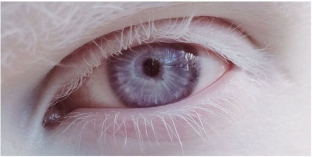Not so long ago, researchers discovered a tribe in Southern Panama whose name in translation meant "moon children", since they were all albinos and were predominantly nocturnal due to the fact that the sun burned their skin and blinded their eyes. The absence of pigment in the body and, in connection with this, the often reddish tint of the eyes, combined with unnaturally white skin, could in the Middle Ages be sufficient grounds for accusing a person of vampirism and witchcraft. But in essence, albinism in a person brings trouble only to himself.
Why does a person have albinism and how to recognize it
Albinism is the genetically determined absence of the pigment melanin in the body, which is responsible for the color of the skin, hair, and some eye tissues.
A person may have albinism:
- full – when there is no pigment in the body at all, in this condition, absolutely all the skin of a person is pale pink, eyelashes, eyebrows, hair are discolored, eyes are light blue or even reddish due to translucent vessels;
- partial – when there is no pigment only in certain organs, for example, in hair, eyelashes, eyes.
The reason for the development of albinism in humans is a genetic defect in which the synthesis of the tyrosinase enzyme is impaired, and the pigment melanin ceases to be produced or its synthesis is insufficient. This hereditary defect is transmitted in a recessive manner, often a woman is the carrier of the defective gene. She does not normally have albinism, but she may pass this genetic disorder on to her son.
Carriers of the albinism gene, as a rule, have mild outward signs of such a deviation:
- freckles;
- very blond hair and eyes;
- thin "porcelain" leather;
- pale fundus.

The troubles that albinism brings to the patient
The main danger posed by albinism in humans – these are serious vision problems. It is not uncommon for a child with albinism to be born with only 5% vision. Lack of pigment leads to & nbsp; to photophobia, the patient complains that he cannot tolerate sunlight and can only see normally at dusk. In addition to nyctalopia, people with insufficient melanin production suffer from strabismus, nystagmus, and they often develop cataracts.
Another problem of albinism – this is a very high risk of malignant skin diseases, since it is exclusively & nbsp; sensitive to ultraviolet radiation, and a person with such pale skin is absolutely not protected from the effects of sunlight.
In addition to the above, albinism entails increased dryness of the skin, impaired sweating, impaired body hair levels (increased or, conversely, reduced), reduced immunity, problems with childbearing.
Albinism in humans may be a manifestation of other diseases associated with genetic disorders – e.g. Angelman syndrome.
Diagnostics and options for correcting the condition of albinism
There are a sufficient number of genetic tests that allow you to diagnose a gene mutation, and to identify a deviation even before the baby is born. If there are suggestions about the likely carriage of a defective gene, it is worth discussing the possibility of childbearing with specialists in advance.
There is no treatment for albinism in humans, because so far science does not suggest the possibility of influencing the synthesis of tyrosinase or filling its deficiency in the body. Symptomatic treatment of deviations with vision is possible. A child with albinism should be aware that he should always be extremely careful with the sun's rays, wear closed clothing and protect his eyes, use sunscreen for the skin.









Add a comment